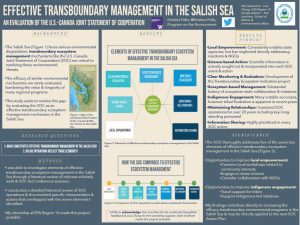Effective Transboundary Management In The Salish Sea: An Evaluation Of The Joint Statement Of Cooperation
The Salish Sea has been subject to substantial environmental degradation including toxic contamination, resource exploitation, species decline, and unchecked urban sprawl. In response, collaborative environmental mechanisms that capture the entire ecosystem from Washington state to British Columbia are essential to conserving the health of this transboundary region. The Joint Statement of Cooperation (SOC) is a management mechanism signed by EPA and Environment and Climate Change Canada (ECCC) specifically designed to protect and restore the Salish Sea. The purpose of this study was to define effective ecosystem management in the region and evaluate the SOC as an effective mechanism based on this criterion. To achieve these objectives, I conducted a literature review to identify elements that comprise effective Salish Sea ecosystem management. I also completed a historical review of SOC operations through an internship at EPA Region 10 to compare to my definition of effectiveness. The following seven elements, local empowerment, science-based action, clear monitoring and evaluation, ecosystembased management, indigenous engagement, maintaining relationships, and information sharing emerged as key to effective regional environmental management and formed my evaluation criterion. Although the SOC addresses many of these components, my evaluation concluded it must prioritize local empowerment and indigenous engagement to be considered wholly effective. The lack of detailed evaluations and frameworks associated with transboundary ecosystem management efforts have burdened the productivity and longevity of many similar partnerships. My findings contribute to resolving this gap as they will directly influence future SOC Action Plans and may also be applied to similar transboundary regions.
